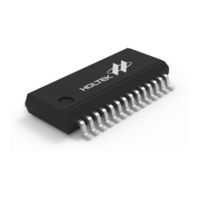User Manuals: HOLTEK HT32F52230 32-bit microcontroller
Manuals and User Guides for HOLTEK HT32F52230 32-bit microcontroller. We have 1 HOLTEK HT32F52230 32-bit microcontroller manual available for free PDF download: User Manual
HOLTEK HT32F52230 User Manual (366 pages)
32-Bit Microcontroller with Arm Cortex-M0+ Core
Brand: HOLTEK
|
Category: Microcontrollers
|
Size: 3 MB
Table of Contents
-
-
Introduction30
-
Features30
-
-
Page Erase34
-
Mass Erase35
-
Register Map40
-
-
-
-
Introduction57
-
Features58
-
Register Map62
-
-
-
Introduction69
-
Features71
-
-
Register Map77
-
-
-
-
Introduction98
-
Register Map100
-
-
-
Introduction104
-
Features105
-
Register Map107
-
-
-
-
Introduction130
-
Features131
-
Register Map132
-
-
-
Introduction137
-
Features138
-
Register Map139
-
-
-
Introduction140
-
Features140
-
Register Map143
-
-
-
-
Introduction152
-
Features153
-
-
ADC Clock Setup154
-
Conversion Mode154
-
Data Format158
-
Analog Watchdog158
-
Interrupts159
-
-
Register Map160
-
-
-
-
Introduction175
-
Features176
-
-
Counter Mode177
-
Clock Controller180
-
Slave Controller182
-
Input Stage189
-
Output Stage193
-
-
Register Map201
-
-
-
-
Introduction236
-
Features236
-
Register Map239
-
-
-
Introduction242
-
Features243
-
-
Counter Mode243
-
Clock Controller244
-
Slave Controller246
-
Input Stage249
-
Output Stage250
-
-
Register Map253
-
-
-
-
Introduction269
-
Features269
-
Register Map272
-
-
-
-
Introduction278
-
Features279
-
-
Data Validity280
-
Arbitration284
-
Bus Error285
-
Address Snoop285
-
Operation Mode285
-
Register Map292
-
-
-
-
Introduction307
-
Features308
-
-
Master Mode308
-
Slave Mode308
-
Status Flags313
-
-
Register Map315
-
-
-
-
Introduction326
-
Features327
-
-
Irda332
-
RS485 Mode335
-
Register Map340
-
-
-
-
Introduction354
-
Features355
-
-
Register Map358
-
Advertisement
